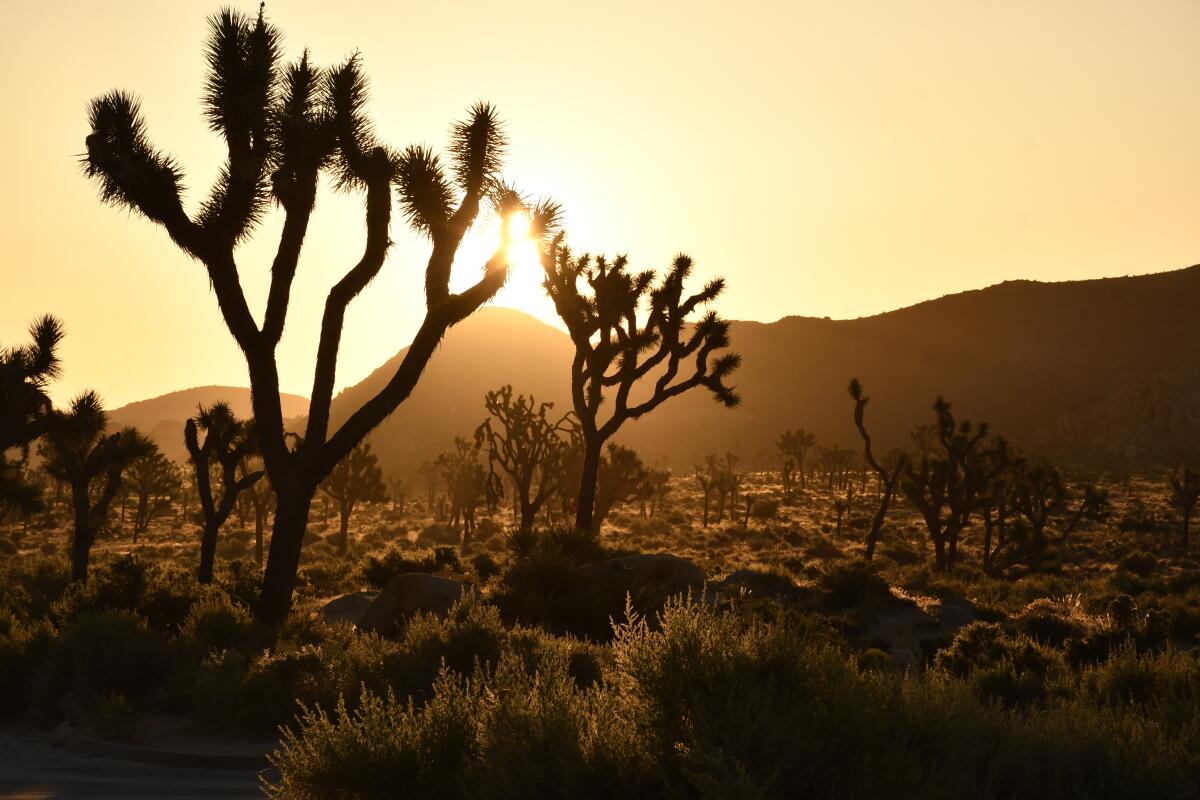
Good morning. Here’s what you need to know to start your day.
- The state outlines a plan to protect its Joshua trees.
- Newsom and Schiff sharply criticized President Biden for pardoning his son Hunter.
- At Nevada’s Clown Motel, the vibe is creepier than ever, and business is good.
- And here’s today’s e-newspaper.
Sign up for Essential California
The most important California stories and recommendations in your inbox every morning.
You may occasionally receive promotional content from the Los Angeles Times.
The plan to protect Joshua trees from a ‘death-by-a-thousand-cuts’ fate
Their silhouettes are unmistakable: gnarled branches stretched out and up, greeting the desert sky with shocks of spiky leaves.
As both a refuge and grocery store for dozens of native species, Yucca brevifolia are an integral part of the Mojave Desert ecosystem.
Growing up in the Antelope Valley, Joshua trees were pretty much everywhere that wasn’t paved. Their ubiquity made it easy to take them for granted.
And though the succulents (part of the agave family and not actually trees) are currently considered abundant across their desert and mountain ranges, their habitat is threatened by a host of human-fueled threats: climate change, wildfires and development.

In response, the California Department of Fish and Wildlife has drafted a new survival plan for the state’s western Joshua trees. Its purpose is “to lay the groundwork for long-term conservation of the species and the desert ecosystems on which it depends,” department Director Charlton H. Bonham wrote.
“The plan does not spell out exactly how much land should be prioritized for protection, or where it is,” my colleague Alex Wigglesworth reported last week. “But it lists criteria for ranking its conservation value, like having a high density of healthy Joshua trees and existing within an area where conditions are cooler and wetter than much of the rest of the range.”
What’s in the plan?
One key goal is land conservation to “permanently protect western Joshua tree habitat from development and other incompatible human uses,” the plan’s authors state.
That means prohibiting and limiting development in certain areas, Alex noted, “including those where the plant may be able to thrive in a future anticipated to be warmer and drier, even as other portions of its range become uninhabitable.”
Those future areas are known as the predicted climate refugia, places where researchers believe that the species will be able to continue to survive the hotter, drier conditions that will become a reality with climate change.

Right now, that zone makes up just 23.4% of the western Joshua tree’s range in the state, according to the plan.
The plan also outlines a collaborative co-management of Joshua trees and their habitat with the state’s Native American tribes. Authors also call on local, state, and federal government agencies to develop or strengthen strategies to protect Joshua trees from development, wildfires and other threats.
Are Joshua trees actually a threatened species?
That depends on whom you ask.
State biologists previously came out against designating the species as threatened by extinction, stating that they are “currently abundant and widespread.”
But many environmentalists say the key is to be proactive and ensure protections for the species before the threat is fully realized.

The plan’s authors note that about a third of the western Joshua trees’ range in California is on privately owned land, where protections are limited.
And development — including clean energy projects aimed at helping the environment — are taking a toll on western Joshua trees. Thousands have been bulldozed to make way for sprawling solar panel fields in the Mojave Desert.
Wildfires, which studies show are spreading faster and causing more damage, are another key threat. Two large blazes have killed an estimated 1.8 million Joshua trees in and around the Mojave National Preserve in recent years.
“The Joshua tree is widespread and abundant now, but you have all these pressures with development, with wildfire and then, on top of that, climate change,” Drew Kaiser, a senior environmental scientist at the California Department of Fish and Wildlife, told Alex. “That really is a death-by-a-thousand-cuts kind of situation.”
The department’s plan was mandated by the Western Joshua Tree Conservation Act, a state law enacted last year. The law also requires developers to obtain permits and pay fees when they kill, damage or remove Joshua trees as part of construction projects. The revenue from those fees are designated to fund efforts to acquire and manage suitable habitat for the Joshua trees.
You can read more from Alex on the state of the state’s Joshua trees and check out the full draft plan here.
Today’s top stories

Newsom and Schiff sharply criticized President Biden for pardoning his son Hunter
- Gov. Gavin Newsom and Sen.-elect Adam B. Schiff, two of California’s most prominent Democrats, expressed disappointment in President Biden’s controversial pardon.
- The break with the outgoing president was significant for Newsom, who acted as an emphatic surrogate for Biden’s 2024 presidential campaign.
- Meanwhile, the judge who presided over Hunter’s federal tax case in Los Angeles denounced President Biden’s pardon, saying he misrepresented son’s criminal case.
- Now pardoned, Hunter Biden looks at the future.
What we know in the mystery surrounding Hannah Kobayashi
- The Los Angeles Police Department is now classifying Kobayashi as a “voluntary missing person” after video showed her crossing the border into Mexico. Here’s a timeline of what is known about her movements.
- Kobayashi’s family said they weren’t giving up the search and urged law enforcement and the public to “stay focused on finding her and to avoid speculative conclusions.”
Shohei Ohtani will recoup $325,000 worth of baseball cards that his former interpreter bought with the Dodgers star’s money
- Former interpreter Ippei Mizuhara bought the cards shortly after Ohtani joined the Dodgers, apparently hoping they would increase in value.
- Mizuhara admitted this year to stealing nearly $17 million from Ohtani to pay off sports betting debts.
What else is going on
- Nathan Hochman was sworn in by Arnold Schwarzenegger as Los Angeles County district attorney.
- Democrats flipped a seat in California’s Central Valley in the nation’s final outstanding House race.
- Newly elected Los Angeles school board members vowed to defend vulnerable students and staff against Trump.
- A California bill aims to address a rise in countertop cutters suffering an incurable and fatal disease.
- A man smuggled weapons to North Korea after coming to California as a student, federal authorities allege.
Get unlimited access to the Los Angeles Times. Subscribe here.
Commentary and opinions
- The GOP and Musk unveiled a threat to Social Security, business columnist Michael Hiltzik writes.
- President Biden’s pardon of his son Hunter is understandable, but it’s also unforgivable, columnist Robin Abcarian writes.
- Democrats could use the lame-duck session to save drugs used for medically induced abortions, writes Erwin Chemerinsky, a contributing opinion writer and dean of the UC Berkeley School of Law.
- Biden should arm Ukraine to the teeth to prepare for the best negotiated peace deal, argues Mikhail Alexseev, a professor of international relations at San Diego State University.
This morning’s must reads
Brash power player Ari Emanuel appears well positioned to maneuver through the new Trump administration as Hollywood attempts to navigate the next four years. Emanuel has close ties to Donald Trump and his allies, but he told The Times he will not be shy about voicing his concerns to the incoming president.
“If I really disagree with something that I think he would do, I will definitely pick up the phone,” Emanuel said.
Other must reads
- Thailand’s starring role in the upcoming season of “The White Lotus” is about to pay off.
How can we make this newsletter more useful? Send comments to [email protected].
For your downtime

Going out
- 🤖 An AI-powered massage robot called Aescape has arrived in Los Angeles.
- 🤡 At Nevada’s Clown Motel, the vibe is creepier than ever, and business is good.
- 🎥 Long in touch with her “more feral side,” Amy Adams connects with “Nightbitch.”
- ⚰️ Monsters obsessed him as a child. Now Robert Eggers is about to unleash his own “Nosferatu.”
- 🍴 Venice stalwart the Rose will close after 45 years.
Staying in
- 📚 Songwriter and composer Randy Newman reveals what he learned from a new biography that examines his life.
- 🧾 “Real Housewives” star Heather Gay has a lot to say now that she’s left the Mormon church.
- 🔧 A Los Angeles resident transformed her 600-square-foot apartment with a stunning makeover for $2,500.
- 🧑🍳 Here’s a recipe for warm persimmon cake with orange and olive oil.
- ✏️ Get our free daily crossword puzzle, sudoku, word search and arcade games.
A question for you: Which famous Californian, living or dead, would you want to have dinner with and why?
Tim Stehly writes: “I would enjoy very much having dinner with Herb Caen, longtime columnist for the San Francisco Chronicle.
“Herb’s daily column brought insights into life in San Francisco at all levels from his club-hopping adventures, which noted sightings of key celebrities around town, to the joy and frustrations of being a dedicated Jaguar owner.
“These insights were put forward with a combination of humor, journalistic reporting and personal observations that described daily life in the city. It was truly a delight to start each day with Herb Caen.”
Email us at [email protected], and your response might be included in the newsletter this week.
And finally … your photo of the day

Today’s great photo is from Dee Carey of Seal Beach: the Seal Beach Municipal Pier, which is one of the longest wooden piers in California.
Dee writes: “I took this photo from the Seal Beach Pier on the evening of Jan. 1, 2020. I was struck by the natural beauty and by the sight of the families who came to the beach, likely full of hope for the new year and the new decade. Little did any of us know what was coming our way in March.”
Show us your favorite place in California! Send us photos you have taken of spots in California that are special — natural or human-made — and tell us why they’re important to you.
Have a great day, from the Essential California team
Ryan Fonseca, reporter
Defne Karabatur, fellow
Andrew Campa, Sunday reporter
Hunter Clauss, multiplatform editor
Christian Orozco, assistant editor
Stephanie Chavez, deputy metro editor
Karim Doumar, head of newsletters
Check our top stories, topics and the latest articles on latimes.com.
